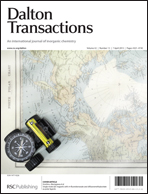Lead(ii) tetrafluoroborate and hexafluorophosphate complexes with crown ethers, mixed O/S- and O/Se-donor macrocycles and unusual [BF4]− and [PF6]− coordination†
Abstract
The reaction of Pb[BF4]2 in H2O/MeCN solution with the macrocycle 18-crown-6 gave the dinuclear complex [{Pb(18-crown-6)(H2O)(μ2-BF4)}2][BF4]2, containing two nine-coordinate lead centres, each bound to all six oxygens of a crown ligand, one water molecule and bridged by two μ2-BF4 groups. In contrast, the oxa-thia crown [18]aneO4S2 gave the mononuclear [Pb([18]aneO4S2)(H2O)2(BF4)][BF4] in which the lead is coordinated O4S2 within the puckered ring of the macrocycle, and with two water molecules on one side of the plane and a chelating (κ2) BF4− on the other. The [Pb([18]aneO4Se2)(BF4)2] has the two BF4− groups arranged mutually cis and with the macrocycle folded; within each BF4− group the Pb–F distances differ by ∼0.5 Å, producing a very unsymmetrical chelate. The 15-membered ring macrocycles 15-crown-5 and [15]aneO3S2 produce sandwich complexes [Pb(macrocycle)2][BF4]2 which contain 10-coordinate lead centres. Pb[PF6]2 in H2O/MeCN solution formed [Pb(18-crown-6)(H2O)2(PF6)][PF6] and [Pb([18]aneO4S2)(H2O)2(PF6)][PF6] which contain weak κ2-coordination of the PF6− group on the opposite side of the macrocyclic ring to two coordinated water molecules, giving 10-coordinate lead. In contrast, [Pb([18]aneO4Se2)(PF6)2] has two κ2-coordinated PF6− groups disposed cis, with a very folded macrocycle conformation. In [Pb(18-crown-6)(NO3)(PF6)] a chelating nitrate group occupies the coordination sites at Pb(II) instead of the two water molecules, and the weakly coordinating PF6− group is tridentate. The crystal structures of the lead nitrate complexes, [Pb(15-crown-5)(NO3)2] and [Pb([18]aneO4Se2)(NO3)2], containing nine- and 10-coordinate lead respectively, are also reported. In solution the complexes are labile, and both conductivity and 19F NMR spectroscopic studies show the BF4− and PF6− groups are dissociated, whereas in the nitrate complexes the anion coordination is retained in solution. The identification of the coordination modes of the NO3− and BF4− groups in the solid complexes by IR spectroscopy is discussed.
![Graphical abstract: Lead(ii) tetrafluoroborate and hexafluorophosphate complexes with crown ethers, mixed O/S- and O/Se-donor macrocycles and unusual [BF4]− and [PF6]− coordination](/en/Image/Get?imageInfo.ImageType=GA&imageInfo.ImageIdentifier.ManuscriptID=C3DT32999B&imageInfo.ImageIdentifier.Year=2013)

 Please wait while we load your content...
Please wait while we load your content...